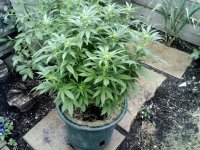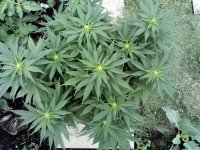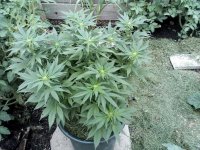vitamingreeninc
Member
So my take on what you are saying is that it is beneficial to defoiliate in veg, it forces the plant to produce new vegetation, and therefore grow larger roots...and I also take from what you are saying abit the flowering could be delayed because of the older leaves, so does that mean you believe a defoliation of 25-35%~ would help transisition the plant to flower in a shorter amount of time?
In general, it is considered most important that the plant be healthy for it to produce high THC levels. The genotype of the plant, a result of seed selection, is the primary factor which determines the THC levels. After that, the provision of adequate organic nutrients, water, sunlight, fresh air, growing space, and time for maturation seems to be the key to producing high-THC Cannabis in all circumstances. Stress resulting from inadequacies in the environment limits the true expression of phenotype and cannabinoid potential. Cannabis finds a normal adaptive defense in the production of THC laden resins, and it seems logical that a healthy plant is best able to raise this defense. Forcing plants to produce is a perverse ideal and alien to the principles of organic agriculture. Plants are not machines that can be worked faster and harder to produce more. The life processes of the plant rely on delicate natural balances aimed at the ultimate survival of the plant until it reproduces. The most a Cannabis cultivator or researcher can expect to do is provide all the requisites for healthy growth and guide the plant until it matures.
Flowering in Cannabis may be forced or accelerated by many different techniques. This does not mean that THC production is forced, only that the time before and during flowering is shortened and flowers are produced rapidly. Most techniques involve the deprivation of light during the long days of summer to promote early floral induction and sexual differentiation. This is sometimes done by moving the plants inside a completely dark structure for 12 hours of each 24-hour day until the floral clusters are mature. This stimulates an autumn light cycle and promotes flowering at any time of the year. In the field, covers may be made to block out the sun for a few hours at sunrise or sunset, and these are used to cover small plants. Photoperiod alteration is most easily accomplished in a greenhouse, where blackout curtains are easily rolled over the plants. Drug Cannabis production requires 11-12 hours of continuous darkness to induce flowering and at least 10 hours of light for adequate THC production (Valle et al. 1978). In a greenhouse, supplemental lighting need be used only to extend daylength, while the sun supplies the energy needed for growth and THC biosynthesis. It is not known why at least 10 hours (and preferably 12 or 13 hours) of light are needed for high THC production. This is not dependent on accumulated solar energy since light responses can be activated and THC production increased with only a 40-watt bulb. A reasonable theory is that a light-sensitive pigment in the plant (possibly phytochrome) acts as a switch, causing the plant to follow the flowering cycle. THC production is probably associated with the induction of flowering resulting from the photoperiod change.
Cool night temperatures seem to promote flowering in plants that have previously differentiated sexually. Extended cold periods, however, cause metabolic processes to slow and maturation to cease. Most temperate Cannabis strains are sensitive to many of the signs of an approaching fall season and respond by beginning to flower. In contrast, strains from tropical areas, such as Thailand, often seem unresponsive to any signs of fall and never speed up development.
Contrary to popular thought, planting Cannabis strains later in the season in temperate latitudes may actually promote earlier flowering. Most cultivators believe that planting early gives the plant plenty of time to flower and it will finish earlier. This is often not true. Seedlings started in February or March grow for 4-5 months of increasing photoperiod before the days begin to get shorter following the solstice in June. Huge vegetative plants grow and may form floral inhibitors during the months of long photo-period. When the days begin to get shorter, these older plants may be reluctant to flower because of the floral inhibitors formed in the pre-floral leaves. Since floral cluster formation takes 6-10 weeks, the initial delay in flowering could push the harvest date into November or December. Cannabis started during the short days of December or January will often differentiate sex by March or April. Usually these plants form few floral clusters and rejuvenate for the long season ahead. No increased potency has been noticed in old rejuvenated plants. Plants started in late June or early July, after the summer solstice, are exposed only to days of decreasing photoperiod. When old enough they begin flowering immediately, possibly because they haven’t built up as many long-day floral inhibitors. They begin the 6-10 week floral period with plenty of time to finish during the warmer days of October. These later plantings yield smaller plants because they have a shorter vegetative cycle. This may prove an advantage. in greenhouse research, where it is common for plants to grow far too large for easy handling before they begin to flower. Late plantings after the summer solstice receive short inductive photoperiods almost immediately. However, flowering is delayed into September since the plant must grow before it is old enough to flower. Although flowering is delayed, the small plants rapidly produce copious quantities of flowers in a final effort to reproduce.





